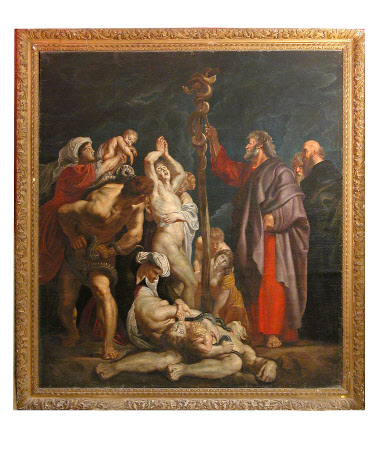The Brazen Serpent (after Rubens)
after Sir Peter Paul Rubens (Siegen 1577 - Antwerp 1640)
Category
Art / Oil paintings
Date
1610 - 1629
Materials
oil on canvas
Measurements
1683 x 1498 mm (66 1/4 x 59 in)
Order this imageCollection
Stourhead, Wiltshire
NT 732085
Caption
In the biblical story of the Old Testament the Israelites' lack of faith is punished by a plague of poisonous snakes. When they repent, Moses asks God how they can be saved and is told to make a serpent of brass. It would then cure all who looked at it. This picture is a copy of the original in the Courtauld Institute, London which Rubens painted after a trip to Italy. He was inspired by classical sculpture, like the famous statue of the Laocoön, and its influence on Renaissance artists, evident here in his emotive depiction of the contorted bodies.
Summary
Oil painting on canvas, The Brazen Serpent (after Rubens), after Sir Peter Paul Rubens (Siegen 1577- Antwerp 1640), early 17th century. Moses stands on the right, robed in red and purple and with dark grey hair and beard. He holds up a brass snake twisted around a cruciform pole with his right hand. The male figure wearing a black cloak who stands beside Moses is probably his brother, Aaron. To the left, on the opposite side of the brazen serpent a group of figures, some partially naked, others entwined with snakes, beg for mercy against the backdrop of a dark and stormy sky. A woman in red desperately holds her baby up. Below, a naked male figure wrestling with snakes turns his head back towards it whilst an undraped male figure raises his arms and clasps his hands in an attitude of supplication and a woman holding white drapery clings to him. Behind, on the ground, another couple kneel and raise their heads upwards. The tragedy of the Israelites' plight is played out at the foot of the pole where the dead bodies of a man, woman and child lie where they have fallen. An old woman attempts to cure the woman by tilting her head upwards to look at the brass serpent. The biblical story of Moses and the brazen serpent is related in Numbers 21: 4-9. In this representation, the brazen snake occupies the centre of the image, splitting the picture into two halves. It is a copy of the painting of around 1609/10 by Rubens in The Princes Gate Collection, Courtauld Institute.
Provenance
Introduced (from Wavendon?) between 1907 -13; given to the National Trust along with the house, its grounds, and the rest of contents by Sir Henry Hoare, 6th Baronet (1865 – 1947), 1946.
Credit line
Stourhead, The Hoare Collection (The National Trust)
Makers and roles
after Sir Peter Paul Rubens (Siegen 1577 - Antwerp 1640)

